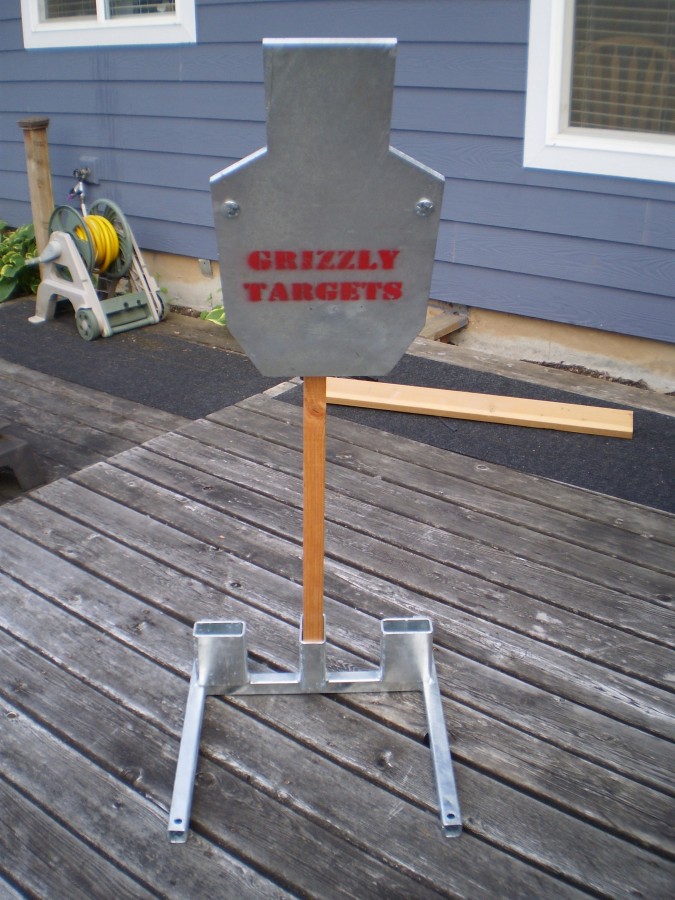
Shooting steel is awesome, and Grizzly Targets’ robust IPSC Torso reactive target is possibly the best defensive training aid I’ve ever tested. It’s a snap to set up, it will last for thousands of rounds, and it even packs flat in the bed of your pickup . . .
Joe Grine and I do a lot of shooting together, and we’ve gotten into shooting steel in a big way. Unless you’re shooting steel-core ammo or training up for bedroom-distance CQB, there’s nothing not to like. The targets last basically forever, you never need to reset them while shooting, and they ring out instant feedback on whether your shooting rocks or sucks.
This Grizzly IPSC Torso reactive target is a solid piece of kit that will save you a lot of range time. It might not necessarily save you ammo, because you’ll probably spend all that extra range time busting caps instead of checking your targets.
That’s not a bad thing, is it?
The Kit
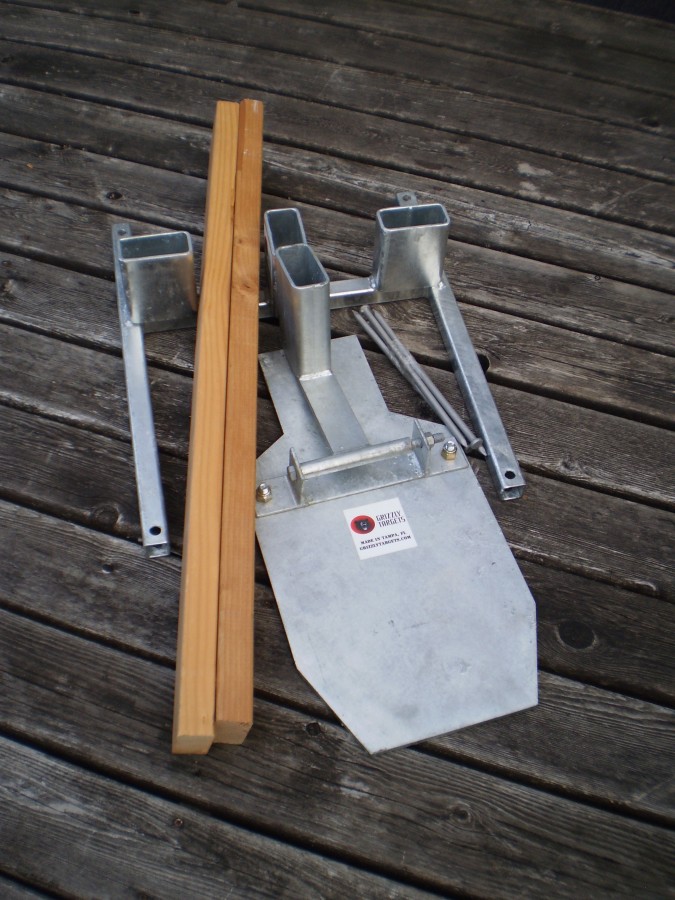
The Grizzly IPSC torso target comes with a 3/8″ silhouette plate of AR500 steel, 11.75″ wide and 23.5″ tall. There are no secondary ‘flapper’ targets mounted within it. This plate bolts to a hinged bracket, which slips over the top end of a 2×4. The bottom end of the 2×4 slips into the 23″ by 18″ base. The kit also includes some heavy-duty stakes, which you probably won’t use unless you’re shooting on very soft soil.

The optional ($15 extra) base on our test target has two extra 2×4 sockets welded at the sides, so you can use it with two 2×4 sections as a regular target stand kind of like this. This gives you a lot of extra flexibility if you’re shooting steel ammo (got Mosin?) or at very close range, or if you just want to put some groups on paper. Grizzly even throws in a cardboard silhouette for this, which I totally forgot to staple up for this photo.
The target plate and bracket weigh 35 or 40 pounds, and the whole assembled target weighs a little more than 50 pounds.
Setup
Assembly couldn’t be much simpler. Insert the 2×4 into the base, put the target bracket on the 2×4, and back up: your range is now hot. The only hard part is lugging it all downrange, particularly if you’ve got to hoof it 300 or 500 yards out.
There aren’t any questions about disassembly, are there?
The corners of the base are drilled so you can stake it into the ground if it’s windy. Grizzly includes a handful of stakes for this, but if it’s ever windy enough to blow over a 50-pound steel target you’ll probably find me doing something indoors.
Safety
In a perfect world, targets would last forever, absorb all projectiles and call your hits for you. Steel targets can only do two out of three, because those shattered and splattered bullet chunks have to go somewhere. Shooting at steel requires a few extra safety considerations:
- Eye protection is always important, but it’s extra important when you’re shooting steel.
- 23 feet is the recommended minimum target distance for shooting handgun calibers at steel, and centerfire rifles should be 50 to 150 yards out depending on whom you ask.
- Super-hot varmint rounds like the .22-250 and .220 Swift should be avoided at any distance: their stupid-fast velocities can crater or even punch through 5/8″ AR500.
- NEVER shoot steel at steel. Much 7.62x54R Mosin-Nagant ammo, all surplus 5.45x39mm AK-74 ammo, and all M855 penetrator 5.56 rounds have steel cores which will badly damage AR500 steel targets. If cratering your target plate doesn’t suck quite enough, the steel cores can also ricochet directly back uprange at potentially lethal velocity.
- Steel targets get coated with lead, so wear gloves when you’re hauling it around and don’t touch your face until you’ve washed your hands. Spraying the target plate with white primer and then bright orange or yellow marking paint can help contain the lead between outings, and it will also help you spot your shots until you blast it all off.
The Range Is Hot

Back up to a prudent range, check your backstop, and commence firing. The target plate will swing slightly when you do your part hit (depending on the energy of the round you’re hitting it with) and you’ll hear the gratifying ‘tang’ of a shot well placed. That swinging motion helps absorb some bullet energy, because a 40 pound target plate only has to swing a little bit to neutralize a lot of the power of a 55-grain 5.56 bullet. (But it will flap like a barn door in a windstorm if you connect with a 3″ magnum shotgun slug.)
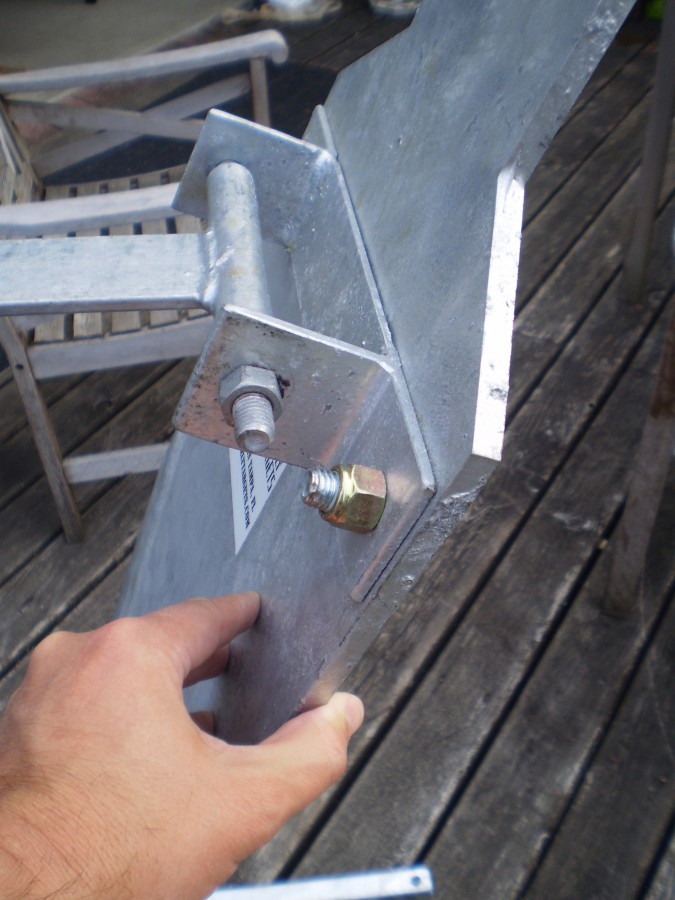
When it’s set up properly, the target plate hangs freely with its head angled toward the shooter at a 27 degree angle. This may be a steeper angle than you expect, but it deflects a lot of the bullet energy like the faceted armor of a modern main battle tank. It also deflects the bullet fragments into the ground at the base of the target, instead of spraying lead and copper up, down and everywhere.
And it also leads us to a discussion of the only part of this target that’s ever likely to wear out: the wooden 2×4 post.
Durability

I’ve been lucky to have a lot of ammo on hand during The Drought, and this Grizzly target has been on the receiving end of a lot of it. It ate at least 100 rounds of .308 at long range (400-500 yards) and more than 750 rounds of various calibers at short or medium range.
As you can see, the target face is just starting to get seasoned with a patina of lead and gilding metal. The bolts are still tight, including the one that took a center-mass hit from a .308. The hinges and brackets are still box-new, and the target face itself has just the tiniest (less than 1mm) surface texturing from all of the impacts.

We nailed the Grizzly with plenty of headshots and hits right along the axis of the pivot. These hits don’t lose as much of their energy to the free-swinging motion of the plate, but they still didn’t do a lick of actual damage.
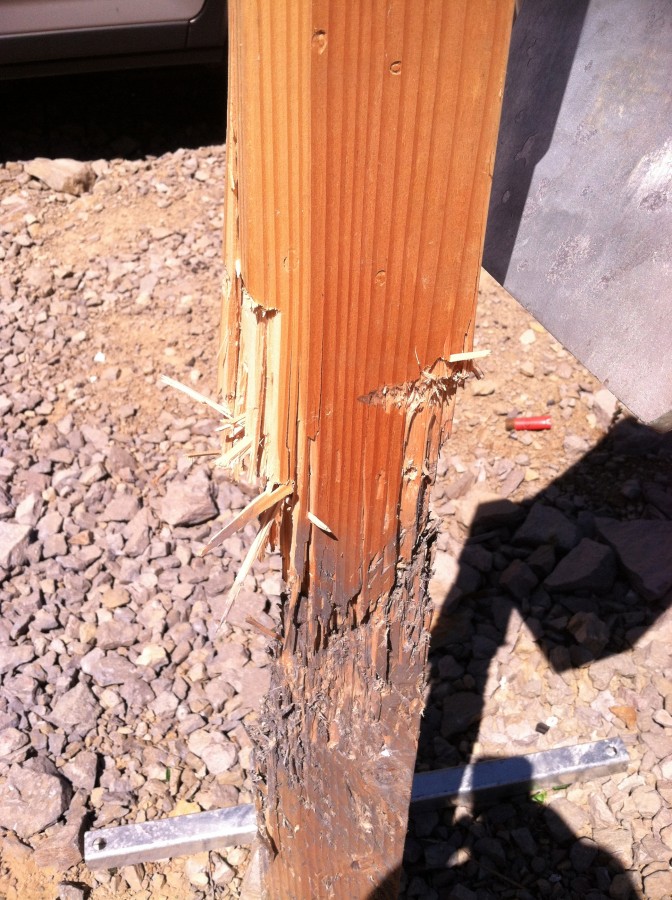
If you steer clear of steel-core ammo, the 2×4 is the only part you’ll ever replace. This 2×4 was hit by more than 750 rounds: .22 rimfire, 9mm, .45, .5.56 (at least 350 rounds) and 7.62 at ranges of 60 to 130 yards. It should be good for another day of shooting before I have to discard it.
Some steel targets have non-hardened steel frames, which can get trashed over time by errant bullets. The replaceable 2×4 gives this Grizzly a durability advantage over those designs, because if you miss the target plate you’ll have to miss really really badly (by more than three feet) before you hit the non-hardened steel base. Through more than 750 rounds on target, even our AK mag dumps weren’t that far off target, and the target base bears no damage at all.
I’m thinking about whether I should rig a crude bumper, possibly cushioned with half a tennis ball, to stand the target plate a little more vertical and keep the 2×4 from getting chewed up. But probably I won’t, because the angle of the armor deflects so much of the bullet energy off of the AR500 steel and into the ground. I’d rather replace a few dollars worth of 2×4 each summer than put extra strain on the $89 target plate.
I can’t even estimate how long this target plate will last through this kind of shooting. It’s coated with lead but essentially undamaged after 750 rounds, at least half of which were from centerfire rifles.
But…Steel Targets Aren’t Invincible
Grizzly Tartets’ Reactive Auto-Reset 220 pepper popper was a big hit several months ago. We beat the crap out of it at ranges far closer than anyone responsible would ever recommended, and it came through like a champ. I thought it would last forever, but a mishap at a public shooting quarry showed me the limitations of steel targets, and the reason why it’s usually best not to shoot around strangers.
I’d put the pepper popper downrange, where other groups of shooters would occasionally shoot at it. This didn’t bother me because I didn’t think anything could go wrong (it’s armor plate, after all) so I was really pissed when some dickhead hosed it down with a couple of magazines of steel-core ammo, probably M855 penetrator. Within minutes the target plate was badly cratered with divots the size of your middle fingertip. These would have made it unsafe to use at pistol distances because of the risk of unpredictable backsplatter.
I wanted to use it for pistols again, so I had to replace the pepper-popper’s small target plate. Grizzly’s sells the small ones for only $39 including shipping, so this won’t be a wallet-shattering event if it happens to you. The new target plate arrived before I even had time to go shooting again anyway.
All of Grizzly’s replacement plates are reasonably priced, but replacing the large torso plate for this IPSC target would be an $89 aggravation. Remember that Grizzly target plates are reversible and hardened on both sides, so if it gets cratered up you can simply unbolt it and flip it around and shoot it for another several thousand rounds.
Summary
Not all steel targets are created equal. I’ve gambled some money on steel targets from eBay, trying to save a few bucks while I saved some range time. Bad idea: when they arrived they could barely survive 9mm hits at ten yards, and a single hit from a .357 carbine destroyed them.
The Grizzly IPSC torso is solid. It’s shrugged off at least 500 rounds of centerfire rifle, most of it at about 60 yards. It’s another great target from Grizzly, and $240 to $255 is a competitive price. If you have four friends you can even do a group buy and get five of the plain-base models delivered for $975 with free shipping.
Ratings?
Since I’m not sure what criteria I’d give ‘stars’ to, I’ll just say that the Grizzly IPSC Torso Reactive Target is strongly recommended for its features, durability and ease of use.
Steel like this isn’t cheap, but it can bring your shooting to a whole new level. Once you get it, you’ll rarely go shooting without it.
(Target provided by Grizzly Targets.)

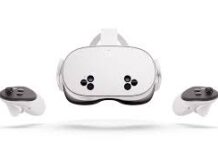

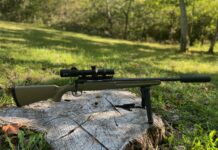
I extremely like the fact you can also use it as a paper holder as well. This is definitely been added to my buy list.
Heh heh, “Gizzly”. Nice one 😉
Fixed!
neat. been wondering about some of these things. thanks much.
For $285 I’d much rather have my action target hostage target 3000+ rounds and still going strong
http://store.actiontarget.com/pt-hostage.html
Agreed. The one thing that concerns me most about this target (and other similarly designed steel targets) is that the exposed bolt heads can cause very unpredictable and possibly dangerous ricochets/splatter back uprange when hit.
The boltless steel target designs, like those used by Action Target, make them a much safer choice IMHO.
I prefer the bolts because the welds are the first to brake. The bolts are easily replaced, and they have taken direct hits with a little wear. The target can be flipped after a few thousand rounds for a second life.
Bolted target designs do have some advantages, such as replaceable bolts, the ability to flip the plates, and are easier to manufacture and therefore are commonly lower cost.
So far, after at least 7500+ rounds of 9mm/40 S&W/.45 ACP, I’ve seen absolutely no issues with cracking welds on my primary practice targets. More rounds, hotter loads, rifle loads and perhaps time, may eventually change the condition of these welds, but everything looks good so far on my Action Target (AT) targets.
I can’t speak for non-AT steel targets, but AT has a very good warranty (below). Personally, I’d rather err of the side of safety and replace a worn-out target if a weld ever cracks (assuming the target is not covered under warranty for some reason). YMMV.
(SIDE NOTE) – The “Steel Resource Guide” from AT has some good information useful to steel shooters. Check it out, and be safe with whatever you choose or prefer!
AT Warranty:
“If any Action Target portable target breaks or fails to perform as explained in the product description, we will fix it or replace it free of charge*. If your target experiences any issues, please contact us via the contact form or by calling customer service toll free at (877) 852-2418.
*Not included in the warranty is normal wear and tear and damage caused to the target through misuse and/or abuse. Action Target portable targets are made of the finest materials and are designed to last, but they are not indestructible. If shot with the wrong caliber and/or at the wrong distance, armor steel may be damaged. Also keep in mind the only parts of the target made of armor steel are those intended to be shot. The stand and other auxiliary parts are made of mild steel and will be damaged if hit by a bullet. Shooting the stand and support parts constitutes misuse of the target. Please refer to the Steel Resource Guide for more details on proper use of steel targets.”
After 20+ years, I’m still clanging away on AR500 steel plates, (different company). One is dinged up a bit from 5.56 ball at 100 yards, but that is some great stuff.
That Grizzly target sounds fantastic. Unfortunately, I cannot justify $285 for a target right now.
I recently acquired some scrap 3/8 inch plate steel. I welded two quick links on the back so I can easily hang them with chain. The plate naturally hangs at an angle toward the shooter which will help deflect hits down to the ground below it. Plus it can swing freely on the chains like a pendulum further absorbing energy and deflecting hits to the ground. The best part? The scrap was basically free and a couple feet of 1/4 inch chain plus the two quick-links were about $5 at my local hardware store.
I know that 3/8 inch steel plate will handle any handgun caliber without any damage whatsoever. I am hopeful they will handle rifle rounds like the .243 and .270 at 100 yards as well. I’ll find out soon enough.
Handgun ammo shouldn’t hurt it much as long as you’re not too close, but rifle bullets will destroy it in short order. I did that myself with some eBay steel targets last year.
My dad has some 8″ circles from this company that we put over the A zone of an IDPA target and are holding up well, even to 357 magnum loads, but I’m thinking about getting one of these for my own practice. Seems to be a heck of a lot cheaper, if you’re fine with the reduced size (just set closer, 10yd for 15yd simulated, etc.
http://www.ar500-targets.com/ProductDetails.asp?ProductCode=66-PERCENT-h
One of the valuable training effects of shooting steel, especially up close with handguns, is the instant recognition of hitting/not hitting as well as where you are hitting. At closer distances you might not be able to hear the hit due to the muzzle blast and ear protection but you can instantly see if and where you are hitting the target. That is, you can instantly see it if you are re-painting the target before it gets to looking like the one in the last picture of the target face. We use steel for reactive shooting training but we repaint the target once you have 12-15 hits on it. Otherwise, you loose the instant recognition of the hit, an essential part of training the subconscious mind for reactive shooting skills. Suggested reading: Bill Rogers’ book Be Fast, Be Accurate, Be the Best. If you must, skip through his history and go directly to sections regarding reactive shooting training and the theories he has developed over the years on how best to do such training. After you’ve read the book, then book a space in his class in Ellijay, GA. Yeah, just blasting away at steel is a ton of fun. You might as well get some training benefit out of it while you’re at it.
great review. i would love to get some silhouette steel targets. i just have redneck scrap metal targets that i set up on the ground. i didn’t catch the price on these. whats the cost?
Retail at $279.00.
Thanks for the review. New addition to my wish list!
Back in the 80s a guy I knew decided that the new game of “Mexican 50-yard chickens” justified buying a .30 Carbine Ruger Blackhawk to go with his beloved M1. He found out that the muzzle blast from PMC ball out of a 7 1/2″ barrel is a bit unpleasant, so he collected the brass from his carbine and reloaded it to black-powder .32-20 pressures and velocities and ran it back though the Blackhawk. One of the most pleasant pistol experiences I’ve ever had – bang! Clang! Chicken down! Totally different and much more pleasant with the downloads than with the factory ball, which was… huge fireball and loud report. Just not manly enough for guns that hurt my wrist and ears I guess; I’ve shot 50 rounds of .44 special for every Magnum round I’ve fired.
What would you say is minimum range before you start seeing real damage for things in the .308 neighborhood?
You might get some target damage inside 50 yards with a .308, but this one shrugs off .308 hits at 50 yards and 7.62×39 hits at 30.
Since I wrote this, we’ve put another 1000+ rounds into this target and it’s still fantastic. One of the edges of the plate got dinged by an angled shot (still works) and one of the bolts has been shot 75% off by repeated rifle hits but it’s still solid. This continues to impress me with its virtual indestructibility.
Comments are closed.